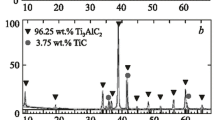The synthesis of Ti3SiC2 in vacuum is studied. The influence of the starting powders, charge composition, and sintering temperature on the phase composition of the material is analyzed. It is established that titanium hydride used instead of metal titanium substantially decreases the onset synthesis temperature and produces almost single-phase material after sintering at 1200–1250°C. However, this Ti3SiC2 does not have adequate density and strength. Practically single-phase Ti3SiC2 with high density and strength is synthesized in the range 1350–1400°C when the silicon content of the charge is higher than its stoichiometric amount by a factor of 1.2–1.25. It is shown that single-phase Ti3SiC2 or material with the required TiC content can be synthesized by variation of silicon content of the charge.




Similar content being viewed by others
References
W. Jeitscko and H. Nowotny, “Die Kristallstruktur von Ti3SiC2—ein neuer Komplexcarbid-Typ,” Monatshefte fur Chem., 98, No. 2, 329 (1967).
H. Nowotny, “Struktuchemie Einiger Verbindungen der Ubergangsmetalle mit den elementen C, Si, Ge, Sn,” Prog. Solid. State Chem., 2, 27 (1970).
W. Jeitschko, H. Nowotny, and F. Benesovsky, “Kohlenstoffhaltige ternare Verbindungen (H-Phase),” Monatshefte Chem., 94, 672 (1963).
J. J. Nikl, K. K. Schweitzer, and P. Luxenberg, “Gasphasenabscheidung im Sistem Ti–Si–C,” Less-Common Met., 26, No. 3, 335–353 (1972).
T. Goto and T. Hirai, “Chemical vapor deposited Ti3SiC2,” Mat. Res. Bull., 22, 1195 (1987).
A. G. Merzhanov and I. P. Borovinskaya, “Self-propagation high-temperature synthesis of refractory inorganic compounds,” Dokl. Akad. Nauk SSSR, 204, 366 (1972).
T. Rudnik, J. Lis, and R. Pampuch, “Optimization of SHS reactions in the Ti–Si–C system in order to control the product properties,” Fourth Eur. Ceram., 4, 431 (1995).
R. Pampuch, J. Biatoskorski, and E. Walasek, “Mechanism of reactions in the Si + C system and self-propagating high-temperature synthesis of silicon carbide,” Ceram. Int., 13, 63 (1987).
R. Pampuch, J. Lis, L. Stobierski, and M. Tymkiewicz, “Solid combustion synthesis of Ti3SiC2,” J. Eur. Ceram. Soc., 5, 283 (1989).
J. Lis, R. Pampuch, J. Piekarczyk, and L. Stobierski, “New ceramics based on Ti3SiC2,” Ceram. Int., 19, 219–222 (1993).
J. Lis, Y. Mijamoto, R. Pampuch, and K. Tanihato, “Ti3SiC2-based materials prepared by HIP-SNS techniques,” Mat. Lett., 22, 163–168 (1995).
Ya. N. Blinovskov, V. S. Gorshkov, D. G. Kellerman, et al., “Synthesis and properties of the new ceramic material Ti3SiC2,” Fourth Eur. Ceram., 4, 251 (1995).
Latest Processes and Materials in Powder Metallurgy (Collected Scientific Papers) [in Russian], Kiev (1997), p. 163.
T. Okano, T. Yano, and T. Iseki, “Synthesis and mechanical properties of Ti3SiC2 ceramic,” Trans. Met. Soc. Jpn., 14A, 597 (1993).
M. W. Barsoum and T. El-Raghy, “A progress report on Ti3SiC2, Ti3GeC2 and the H-phases, M2BX,” J. Mater. Synth. Process., 5, 197 (1997).
M. W. Barsoum, “The M n+1AX n phases: a new class of solids,” Progress Sol. St. Chem., 28, 201–281 (2000).
M. W. Barsoum and T. El-Raghy, “Synthesis and characterization of a remarkable ceramic Ti3SiC2,” J. Am. Ceram. Soc., 79, No. 79, 1953 (1998).
I. I. Ivanova and A. N. Demidik, “Hydride method of producing titanium intermetallics,” Proc. 7th Int. Conf. Hydrogen Materials Science and Chemistry of Metal Hydrides [in Russian], Kiev (2001), pp. 450– 451.
S. A. Firstov, E. P. Pechkovsky, I. I. Ivanova, et al., “High-temperature mechanical properties of powder metallurgy porous lightweight titanium nanolaminates,” High Temp. Mater. Processes, 25, No. 1–2, 47–58 (2006).
S. A. Firstov, V. F. Gorban’, I. I. Ivanova, and E. P. Pechkovsky, “Mechanical behavior of sintered porous two-phase titanium nanolaminate composites at high temperatures,” Eng. Mater., 409, 300–303 (2009).
S. A. Firstov, V. F. Gorban’, A. N. Demidik, et al., “Determining strength and strain of porous two-phase nanolaminates with automated indentation,” Materialovedenie, No. 5, 32–38 (2009).
Author information
Authors and Affiliations
Corresponding author
Additional information
Translated from Poroshkovaya Metallurgiya, Vol. 51, No. 7–8 (486), pp. 79–91, 2012.
Rights and permissions
About this article
Cite this article
Ivanova, I.I., Demidik, A.N., Karpets, M.V. et al. Synthesis of titanium silicon carbide Ti3SiC2 under isothermal sintering. Powder Metall Met Ceram 51, 437–446 (2012). https://doi.org/10.1007/s11106-012-9453-y
Received:
Published:
Issue Date:
DOI: https://doi.org/10.1007/s11106-012-9453-y




